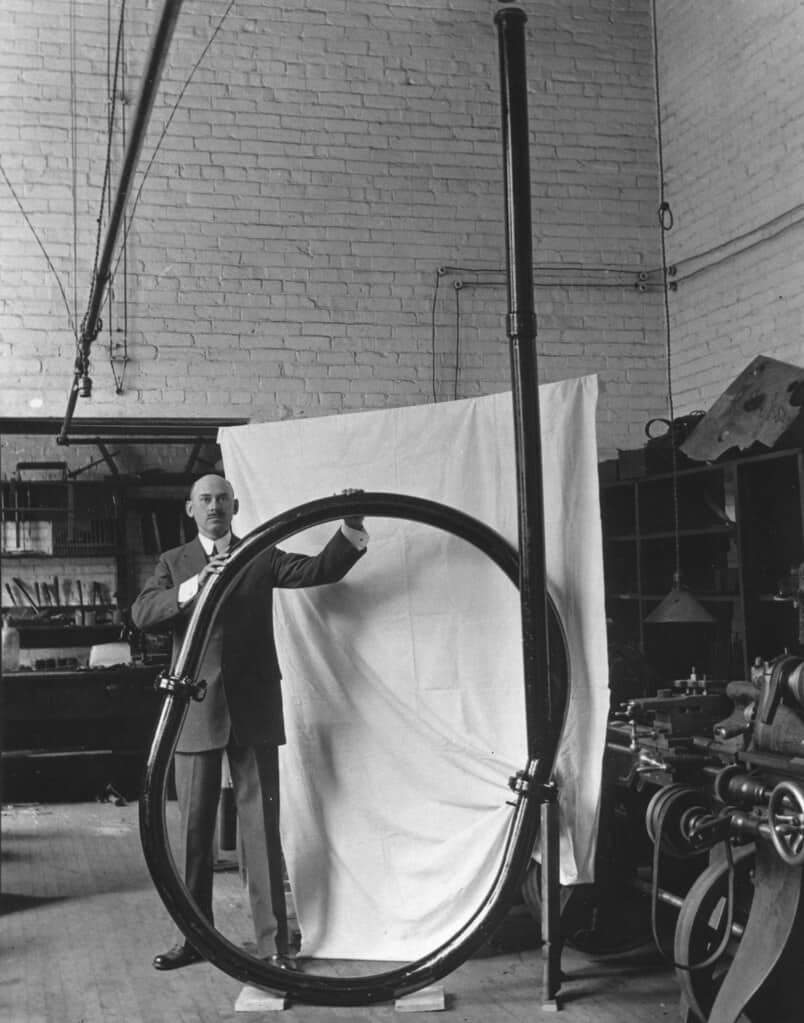Today in History: Dr. Robert H. Goddard, American Rocketry Pioneer

Dr. Robert Hutchings Goddard (1882-1945) is considered the father of modern rocket propulsion. A physicist of great insight, Goddard also had a unique genius for invention. It is in memory of this brilliant scientist that NASA’s Goddard Space Flight Center in Greenbelt, Maryland, was established on May 1, 1959.
By 1926, Goddard had constructed and successfully tested the first rocket using liquid fuel. Indeed, the flight of Goddard’s rocket on March 16, 1926, at Auburn, Massachusetts, was as significant to history as that of the Wright brothers at Kitty Hawk.
Primitive in their day as the achievement of the Wrights, Goddard’s rockets made little impression on government officials. Only through modest subsidies from the Smithsonian Institution and the Daniel Guggenheim Foundation, as well as the leaves of absence granted him by the Worcester Polytechnic Institute of Clark University, was Goddard able to sustain his lifetime of devoted research and testing.
Goddard first obtained public notice in 1907 in a cloud of smoke from a powder rocket fired in the basement of the Worcester Polytechnic Institute physics building. School officials took an immediate interest in the work of student Goddard. The school’s administration, to their credit, did not expel him. He thus began his lifetime of dedicated work.
In 1914, Goddard received two U.S. patents. One was for a rocket using liquid fuel. The other was for a two- or three-stage rocket using solid fuel.
At his own expense, he began to make systematic studies about propulsion provided by various types of gunpowder. His classic document was a study he wrote in 1916 requesting funds from the Smithsonian Institution so that he could continue his research. This was later published along with his subsequent research and Navy work in a Smithsonian Miscellaneous Publication No. 2540 (January 1920). It was entitled “A Method of Reaching Extreme Altitudes.” In this treatise, Goddard detailed his search for methods of raising weather-recording instruments higher than sounding balloons. In this search, he developed the mathematical theories of rocket propulsion.
Toward the end of his 1920 report, Goddard outlined the possibility of a rocket reaching the moon and exploding a load of flash powder there to mark its arrival. The bulk of his scientific report to the Smithsonian was a dry explanation of how he used the $5,000 grant in his research. The press picked up Goddard’s scientific proposal about a rocket flight to the moon, however, and created a journalistic controversy concerning the feasibility of such a thing. The resulting ridicule created in Goddard firm convictions about the nature of the press corps, which he held for the rest of his life.
Goddard’s greatest engineering contributions were made during his work in the 1920s and 1930s. He received a total of $10,000 from the Smithsonian by 1927, and through the personal efforts of Charles A. Lindbergh, he subsequently received financial support from the Daniel and Florence Guggenheim Foundation. Progress on all of his work, titled “Liquid Propellant Rocket Development,” was published by the Smithsonian in 1936.
Goddard’s work largely anticipated in technical detail the later German V-2 missiles, including gyroscopic control, steering by means of vanes in the jet stream of the rocket motor, gimbal-steering, power-driven fuel pumps and other devices. His rocket flight in 1929 carried the first scientific payload, a barometer, and a camera. Goddard developed and demonstrated the basic idea of the “bazooka” two days before the Armistice in 1918 at the Aberdeen Proving Ground in Maryland. His launching platform was a music rack. In World War II, Goddard again offered his services and was assigned by the U.S. Navy to the development of practical jet assisted takeoff and liquid propellant rocket motors capable of variable thrust. In both areas, he was successful.
Robert H. Goddard died on Aug. 10, 1945. Following the rocketry pioneer's death, his widow, Esther Goddard, championed his work. On Sept. 16, 1959, the 86th Congress authorized the issuance of a gold medal in the honor of professor Robert H. Goddard. Esther Goddard was on hand for the formal dedication of NASA's Goddard Space Flight Center on March 16, 1961, 35 years to the day after the professor launched the first liquid-fueled rocket from his Aunt Effie's farm.
Goddard was the first scientist who not only realized the potentialities of missiles and space flight but also contributed directly in bringing them to practical realization. Goddard had a rare talent in both creative science and practical engineering. The dedicated labors of this modest man went largely unrecognized in the United States until the dawn of the Space Age. High honors and wide acclaim, belated but richly deserved, now come to the name of Robert H. Goddard.
Dr. Goddard's Major Contributions
Robert Goddard's contributions to missilery and space flight would make a lengthy list. Below are some highlights.
Explored the practicality of using rocket propulsion to reach high altitudes, even the moon (1912)Proved that a rocket will work in a vacuum, that it needs no air to push againstDeveloped and fired a liquid fuel rocket (March 16, 1926, Auburn, Mass.)Shot a scientific payload in a rocket flight (1929, Auburn, Mass.)Used vanes in the rocket motor blast for guidance (1932, New Mexico)Developed gyro control apparatus for rocket flight (1932, New Mexico)Received U.S. patent for of multi-stage rocket (1914)Developed pumps suitable for rocket fuelsLaunched a rocket with a motor pivoted on gimbals under the influence of a gyro mechanism (1937)
Photo: NASA Goddard Space Flight CenterGoddard with Vacuum Tube Device
Link: https://www.nasa.gov/centers/goddard/about/history/dr_goddard.html











